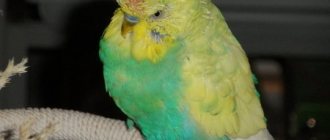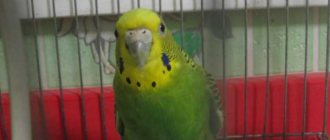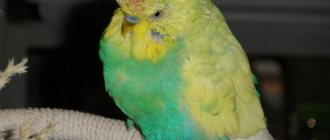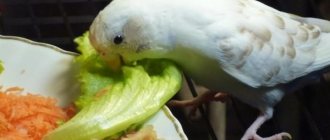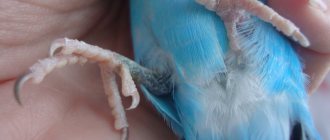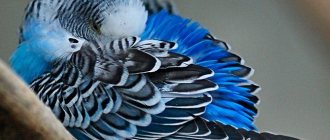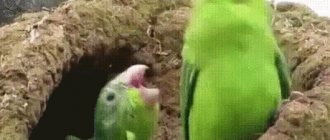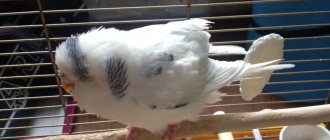Bustling activity, cheerful chirping and constant mischief - this is all about the domestic budgie. We are accustomed to considering wavy fish as real live creatures. And if it suddenly happens that the parrot is sitting at the bottom of the cage, ruffled and with its eyes closed, this is a cause for concern. Why doesn't the bird fly or sit on a perch? This can be explained by observing the pet for some time. Let's consider several possible options.
Poisoning
The decrease in activity occurs as a result of poisoning - the parrot may swallow something dangerous or inhale toxic fumes. Parrots are very curious, they strive to bite and try surrounding objects. You cannot leave your pet unattended during a walk, otherwise he will definitely get into trouble. A poisoned parrot quickly loses strength, sinks to the bottom of the cage and sits with its eyes closed, ruffled, not reacting to external stimuli.
Poisoning in a parrot
The risk of household poisoning contains:
- Medicines. A parrot may mistake bright capsules or tablets lying on the table for a treat.
- Houseplants. Among them there are specimens that are poisonous not only to birds, but also to humans. For example, ivy, dieffenbachia, azalea. Some poison the air, others are dangerous if swallowed, and parrots just love to pinch grass.
- Liquids. A bird can drink from glasses or containers left uncovered: alcoholic drinks, vinegar, coffee, various marinades.
- Aerosols. In high concentrations, perfumes and air fresheners are harmful to parrots. The same list can include fumes from heated Teflon cookware.
- Newspapers magazines. Parrots love to tear paper into pieces and even swallow it. Blank paper is completely harmless, but the same cannot be said about newspapers - the chemicals in printing ink are very toxic.
- Products prohibited for feeding parrots. Often, owners themselves poison their pets when they offer them food from their plate.
Note! A parrot can become poisoned when it chews on a low-quality toy. Pieces of plastic entering the stomach begin to release toxins into the body.
In the best case, the bird experiences a mild intestinal upset after poisoning and recovers quickly. Severe toxic damage deprives the bird of strength and will to live. This is accompanied by such striking symptoms as diarrhea, vomiting, and cramps. An exhausted parrot lies at the bottom of the cage and trembles. If you do not provide assistance to your ward in a timely manner, he will die.
Dangerous manifestations and their consequences
To save the life of a feathered pet, it is important to understand what external signs indicate. For example, why does a parrot tremble or crawl? If you know what the reasons may be, the likelihood of a favorable outcome will increase.
When a parrot crows and closes its eyes, loses weight, coughs and yawns, the bird is probably sick with tuberculosis. The initial stage can be treated with tetracycline antibiotics according to the treatment regimen for psittacosis described above. In other cases, the pet faces death.
When getting a feathered pet, it is better to study the diseases of parrots yourself. This will help you understand what exactly threatens your friend and how to cope with illnesses without outside help. The following symptoms, inconspicuous at first glance, are dangerous:
- lethargy and inactivity;
- disheveled;
- lack of voice;
- the parrot shakes its head;
- dulling of feathers.
What is important to know about parrot diseases is not how to cure the disease, but how to recognize the disease in time. Pay attention to even small deviations in behavior in order to provide timely help or consult a doctor.
Colds
No matter how strange it may sound, domestic parrots, even though they are in “greenhouse” conditions, are more likely to catch a cold than free birds. When kept indoors, fragile pets react more strongly to changes in temperature and humidity and are very afraid of drafts. An open window in hot summer weather is one of the common causes of colds.
Many parrots love to bathe and get this opportunity quite often. However, after water treatments, the bird does not always have time to dry, especially in a cool room, so it catches a cold.
Cold symptoms:
- sneezing;
- runny nose;
- cough;
- chills.
Sneezing is accompanied by discharge from the nostrils; in addition, the parrot feels itching in the respiratory tract and often scratches the wax with its claws. The body temperature rises, trembling appears, the bird tries to warm up and hides its beak in its feathers. The general condition is deteriorating, which affects activity: the feathered pet does not fly or jump, but sits in the corner of the cage, huddled into a ball, conserving energy.
Preventive measures
Domestic parrots, despite their unpretentiousness in keeping, still require comfortable conditions. Their homeland is countries with hot and warm climates, so in captivity they need to create similar conditions. Hypothermia is dangerous for parrots: they can develop kidney disease, which is difficult to treat.
Drafts are strictly contraindicated for these birds - this is probably enemy No. 1 for them. Sharp temperature fluctuations also have a bad effect on feathered friends. They are very gentle and defenseless, susceptible to colds.
Parrots are very susceptible to infections. Owners need to take this into account. They should not approach their pets if they have contracted a respiratory disease. There is a high chance that they will infect their pets. But curing them will be very difficult, and there is a high risk of losing your feathered friend.
Desire to breed
Owners of ornamental birds sometimes observe strange behavior in their charges: the parrot sits for a long time at the bottom of the cage in the corner, and then shakes itself off and flies up onto a perch. You can't tell from his appearance that there is any cause for concern. Such actions suggest the idea: the parrot is preparing for procreation.
Pregnant parrot
If a different-sex couple lives in a cage, it is quite possible that this is how the beginning of nesting manifests itself. It is recommended to support the instincts of pets: set up a nest box for them. But if the only inhabitant in your home’s living area is a female parrot, you need to suppress her desire for offspring. You should remove the mirror, twigs, and paper from the cage. There should be no materials inside from which the bird could build a nest. False incubation must be stopped, otherwise the parrot will lose its health in vain.
First aid
The reason for the hunching, combined with trembling, may be adaptation to new conditions. A parrot becomes anxious if it has been transported from one room to another or transferred to a new cage. Perhaps he requires more attention. You need to talk to him. If a bird attacks a new toy or an object it does not understand, they are removed from the cage. If the next morning the parrot behaves adequately, this means that adaptation has been successful. If the apartment is cold, cover the cage with a towel, leaving a gap and pointing an incandescent lamp at it or the tray.
You can independently correct the situation when a bird develops hypovitaminosis or is poisoned by a delicacy not intended for perroque. The situation can be corrected by introducing a sorbent. Enterosgel is best suited. It is squeezed out of the tube, diluted with water, and 3-4 drops are added using a syringe without a needle. Activated carbon is given in a similar way. You should catch the bird in semi-darkness, covering the cage with a towel to reduce frightening. When trembling and ruffling are associated with injury, the parrot must be urgently taken to the clinic.
Improper feeding
The budgerigar is an active bird, constantly on the move. A healthy parrot jumps from branch to branch, walks along the bottom and pecks grains, tears paper, but it will not sit on the floor of the cage. Then it is not entirely clear why the parrot suddenly began to spend a lot of time below. Probably his paws get tired of clinging to the perch, and it’s more comfortable to sit on the pallet. The reason for this condition is errors in nutrition: excess fatty foods or lack of nutrients.
Obesity in a parrot
You need to feed your pet not on demand, but on time, observing the portion size. If you do not adhere to dietary standards, the parrot will get used to overeating, due to which it will gain excess weight. A heavy body is a load on the legs and wings. An obese bird has difficulty moving and simply feels discomfort.
Monotonous food
On a note! It should also be noted that starvation is one of the reasons for bird weakness. The food may be of poor quality, and the parrot will not get enough of it. In some cases, exhaustion is caused by switching to another food that the pet does not like.
What other symptoms should you be wary of?
In certain cases, contacting a specialist is simply vital. Delay threatens the parrot with death.
Let us highlight the following situations:
- fracture of limbs, tail or wing;
- the appearance of a bleeding wound on the body;
- signs of poisoning and digestive disorders;
- apathy, drowsiness;
- itching of the skin, excessive loss of feathers;
- partial or complete refusal to eat;
- convulsions;
- uncharacteristic cry, wheezing.
The sooner the diagnosis is made, the faster the bird’s condition will improve.
It will be useful for you to know what to do if your parrot constantly screams and creaks its beak.
Illness or injury
If a wavy sits or lies on its belly at the bottom of the cage and breathes heavily, this is an alarming signal. Most likely, this behavior indicates a disease. Avian diseases are more common in parrots that are kept in pairs or flocks. Lonely pets also suffer from infectious diseases, parasitic infestations, joint diseases and metabolic disorders.
The bird cannot sit on a perch in a cage; it lies on its stomach when one or both legs are damaged. These could be ulcers on the soles, gout, arthrosis or other pathologies. A budgerigar has very fragile limbs, and it can easily get injured: a dislocation, a fracture, or a claw being torn off. During free range, young birds often crash into mirrors, glass, furniture, and this is fraught with concussion and rupture of internal organs. If the parrot is ruffled and has closed its eyes, but is not sleeping, you need to examine it. If you notice an unnatural position of the limbs or beak, contact your veterinarian.
Next, we’ll look at options on how you can cope with your pet’s painful condition on your own.
What to do if the parrot died
A beloved pet needs to be buried. Owners of dachas and their own houses can do this in the far corner of the garden. Those who live in an apartment will have to go to the nearest forest. An alternative is to contact a service that bury or cremate animals that die at home.
How to bury
To bury a budgerigar, dig a hole - a depth of about half a meter is suitable. The pet is wrapped in a piece of cloth and placed in a box. The top of the grave is sprinkled with pebbles or covered with turf to protect it from animals.
Those who plan to visit the parrot install an identification mark at the site of the hole.
Cell disinfection
The next step is complete processing of the cell. It is not always possible to fully understand why a pet died, and budgies often become carriers of infectious diseases.
The cage must be washed with a disinfectant. Ecocid-S is suitable, a tablespoon of which must be diluted in a liter of water. After thorough washing, leave the cage for 30 minutes, then rinse well with water. A new tenant can be moved in no sooner than in a week.
Treatment
Every owner should be able to provide first aid to a feathered pet. If you have a cold, it is enough to warm the parrot (turn on an infrared lamp near the cage) and drink it with chamomile infusion.
Poisoning is of particular concern: small parrots have a very fast metabolism. Toxins that enter the body instantly penetrate all systems. A ruffled parrot with its eyes closed involuntarily shows that it needs urgent treatment. Sometimes the hours count.
The procedure for eliminating intoxication:
- Dilute the sorbent (enterosgel, activated carbon, polysorb) with water and pour it into the beak in small portions. You can use a syringe without a needle or a pipette for this.
- Cook the rice in water until it is completely cooked, grind it into a liquid porridge, cool to room temperature. Draw up the food into the syringe and carefully feed the parrot. One dose requires 1.5 ml of porridge.
- Poisoning is accompanied by vomiting and diarrhea. You need to keep your pet's plumage clean and clean the cage often.
A parrot crests under different circumstances, and this should not always cause concern. But if the bird tries to hide in the corner of the cage and lies on its stomach, you cannot leave it without attention. There are several reasons for this behavior: poisoning, illness, injury. After the first symptoms are removed and the parrot’s condition is alleviated, you need to show it to a veterinarian.
Prevention
To reduce the risk of various diseases, and not to see your pet sad and drooping, you must follow the following rules:
- maintain a room temperature of +22-23°C, ensure normal air humidity;
- eliminate drafts, ventilate the room in the absence of birds;
- keep the cage and house clean, regularly disinfect and bathe your pet;
- inspect the parrot’s appearance daily;
- feed with high-quality food, make sure that the food is varied, with a full range of nutrients;
- keep dangerous objects and substances out of reach - sharp utensils, poisonous plants, medicines, piercing instruments and others;
- protect your family friend from fear and stress;
- create the right lighting;
- Take him periodically for examination by a specialist.
These are simple rules that do not require special skills or knowledge. Conscientious care of your wavy pet will help you avoid many problems in the future.
But if you happen to see that the bird has become ruffled and sad, then you need to take action immediately, without leaving it to chance. In caring hands, the injured bird will quickly return to normal and continue its vigorous activity with cheerful chirps.
Why does a parrot sit or lie at the bottom of the cage?
Parrots, like people, differ from each other in character and behavioral habits. But all of them are characterized by active fluttering, cheerful chirping and even talkativeness. And if cheerfulness suddenly gives way to depression, and instead of flying around the room, your feathered friend often sits or lies at the bottom of the cage, then this is alarming. This behavior can be explained by a number of reasons.
Normal behavior
It happens that a parrot sitting on the floor of the cage is the norm. For example, if a chick was born with some kind of pathology on its leg, then it is difficult for it to sit on a perch for a long time, but is more comfortable on the floor. In this case, such damage can be detected upon careful inspection. There is no reason to worry.
The female sitting in the corner of the cage indicates the onset of sexual maturity and readiness to mate, and maybe even waiting for the egg to appear. If the feathered girl is the only representative of her species in the house and no offspring are planned, then she urgently needs to remove the mirror in which she mistakes her reflection for a male from the cage, change the rattle and the general furnishings in the cage, do not put paper or other suitable material on the bottom to create a nest. This will help her get rid of the desire to lay eggs.
If your female has the same wavy friend, who has already become her “husband,” then you cannot cancel the clutch. We need to take care of the house quickly. The future mother will lay eggs in it and begin to hatch them, and the new father will look after her and feed her. You can get rid of unplanned offspring without exposing the female to stress. To do this, you need to scald the newly laid eggs with boiling water and return them to the nest to the unsuspecting mother.
Poor nutrition
A healthy parrot will go to the bottom of the cage from time to time, but never sit for long. If he sits there too long, it means he doesn’t feel well and can’t take off. The cause may be poor nutrition, resulting in the bird becoming too heavy due to obesity or too weak and emaciated.
Excess weight may appear due to:
- a sedentary lifestyle, when the bird is not allowed to fly out of its cage;
- the predominance of high-calorie feeds: canary seeds, hemp, oats.
To avoid such a critical situation, you need to:
- limit feeding of high-calorie grains, and give more fresh herbs, as well as raw fruits and vegetables;
- equip the cage with various perches, ropes, swings to increase the ability to actively move;
- Let the bird out every day for a few hours to fly freely.
The parrot may become weak due to the fact that the food has been changed to new food, which it is not used to eating. To prevent this from happening, you need to switch to a new type of food gradually, gradually adding it to your usual food. You need to buy only good quality concentrate.
Poisoning
Poisoning also deprives the bird's body of strength, which is why the parrot does not fly, but sits on the floor of the cage. Along with this, other symptoms appear: lack of appetite, vomiting, diarrhea, lack of coordination, body trembling, head tilted back. The causes of poisoning, in addition to low-quality and stale food, can be found throughout the apartment.
For example:
- indoor plants poisonous to birds: ivy, dieffenbachia, spurge, azalea;
- Alcoholic drinks and pure salt not removed from the dinner table;
- toxic fumes from Teflon cookware;
- toiletries containing hexachlorophene: cosmetic soap, deodorant spray;
- products containing mercury and other hazardous chemicals.
Diseases or parasite infestation
An exhausted bird sits or lies on its stomach all the time, breathes heavily and sleeps a lot if it is sick or infected with parasites.
Diseases that cause a parrot to sit:
- psittacosis, which spreads from sick birds or appears due to unsanitary living conditions;
- salmonellosis, which birds become infected with through food, water and from other birds;
- thyroid disease;
- gout is a joint disease that occurs due to excessive nutrition;
- goiter inflammation.
Signs of the disease, in addition to the fact that the feathered pet gets ruffled and sits for a long time at the bottom of its home, can be general weakness, diarrhea, refusal to eat, and swelling. Parasites also make the parrot suffer. They are internal, i.e. intestinal (roundworms), and external (fleas and ticks). It can become infected first through bad food and from sick birds, and secondly, also from infected relatives.
Prevention of parasite infection:
- feed only proven high-quality feed;
- observe quarantine when keeping several birds.
Sign of injury
The “lying on its stomach” position may indicate an injury that a curious parrot could accidentally receive while examining the room situation. This could be a dislocation, fracture or inflamed wound. In this case, the bird is depressed, does not want to eat, its legs, head and beak may be in an unnatural position, and swelling in the damaged area may be visible.
Description
Often, owners of parrots and other ornamental birds notice that their pet is breathing heavily only when it is sick, and the disease progresses, affecting the general well-being of the bird. If you notice breathing abnormalities on the first day, this will make further treatment easier.
How to help a parrot if he has trouble breathing
To correctly prescribe therapy by a veterinarian, you need to note in advance the changes that have occurred with the parrot. These may include sudden changes in weight, inappropriate behavior, convulsions and tremors of the wings. It is important to monitor whether the beak is open or closed when breathing, and whether extraneous sounds or noises are heard. This will help in making a clearer and faster diagnosis.
What are the benefits of getting a good night's sleep?
If you can't get enough sleep at night, the parrot will make up for the lack of sleep during the day. In addition to the normal duration of at least 10 hours, sleep should be sound and restful. Why is proper rest so important for birds?
- During sleep, expended energy is replenished;
- the body is restored;
- the state of the nervous system is stabilized;
- immunity is strengthened.
Brief breaks during the daytime promote muscle relaxation, a kind of relaxation. Having had a hearty snack, the parrot dozes off, and metabolic processes go on as usual.
What is the normal saturation level for a healthy person?
The norm for a healthy person is SpO2 = 95-99 (or 100)%. The rate of blood oxygen saturation depends on the individual characteristics of the human body, for example, on the presence or absence of anemia, apnea, chronic diseases of the respiratory and cardiovascular systems, bad habits, and age. At night, each person's saturation decreases, and the differences can be significant. For example, in people with chronic diseases of the respiratory system (COPD, apnea), who have adapted to a constant lack of oxygen, the rate can drop to 90% (in the deep sleep phase).*
According to the observations of doctors working in hospitals with seriously ill patients who are on oxygen, the most dangerous time is from 3 to 7 am. At this time, the largest number of deaths are recorded due to decreased saturation, or more precisely due to oxygen hypoxemia.
RE Gries, LJ Brooks, Normal oxyhemoglobin saturation during sleep. How low does it go? K. Szabó, F. Ihász, The effect of reduced oxygen saturation during sleep on depression, 2020
How to help
What can be done if the parrot is ruffled and unwell? A bird that is not feeling well should not be left unattended. In small parrots, all processes in the body occur at lightning speed, and the bird fades away within a few days. First of all, if you notice something is wrong, watch your pet. You may see other signs of illness. Understand the situation in more detail, examine the room, the cage and the bird itself. Remember what happened before the wavy fluffed up.
You should only take measures that will not harm your pet:
- put the bird away from its neighbors in a separate cage;
- ventilate the room by first covering the cage or moving it to another room;
- ensure silence and cleanliness in the room;
- warm the bird in your palms or under a lamp;
- pour sorbent into the beak from a syringe without a needle;
- drink with warm chamomile decoction;
- Having discovered a wound or fracture, treat and secure with a bandage;
- To maintain strength, give 2–3 drops of glucose.
A domestic parrot is ruffled not only from the cold. When a bird is exhausted, frightened, weak or sick, its feathers become ruffled. If there are no additional symptoms of ill health, then the owner can eliminate the problem himself. But in severe cases, you should immediately contact a veterinarian.
If you liked the article or have something to add, then leave your comments and also join our VKontakte group.
Need for flights
Budgerigars often become residents of city apartments. Their home is a cage on a table, on a windowsill. It seems big, but the bird is not as comfortable in it as in the wide space of a room or an entire apartment, where it can fly freely.
Flight is a vital need associated with the physical well-being of a bird.
Even a parrot that is naturally a poor flyer, or one that cannot fly at all, will try to flutter from the cage to the owner’s shoulder, from the chair to the back of the sofa. The owner should remember that in this way his pet strengthens its bones and resists:
- obesity;
- muscle atrophy;
- depression.
The veterinarian will point out the importance of free-flying pet birds. He will advise giving freedom to wavy pets daily, or up to five times a week.
Bad food
Sometimes the reason for this behavior is poor food. It is better not to use domestic food, but to replace it with imported food. In order for him to quickly get used to the new food, you need to gradually replace the old food with a new concentrate.
You can prepare the food yourself. You need to take the various cereals that you have. Buckwheat, millet, oatmeal, rice and boil a little will do. If the bird is weakened, you need to grind them and pour boiling water over them. Wrap the bowl with the porridge in a warm blanket and let it sit for 15–20 minutes. If the pet is so weakened that it cannot eat on its own, it must be fed. You need to take the cooled, but not cold, porridge into a syringe without a needle, take the bird in your hand, wrap it in a clean soft cloth so that only the head is on top. Hold it with three fingers: the thumb and middle one on both sides of the head, and the index finger on top of the head. Turn the head slightly to the side, open the beak with your fingernail and drop one drop of food into the corner of the beak. There's no need to rush. Wait until he swallows this porridge, then give him more. At one time you should try to give at least 1 1.5 ml of warm porridge.
Your pet should not live in the kitchen, especially if there are non-stick cookware. The bird should also not be given water from a tap or well unless it is boiled. This can be a breeding ground for bacteria for birds.
Features of the course of neurosis in women
Neurosis is diagnosed in a third of the world's urban population. Neurology is one of the most common ailments of the nervous system—the disease occurs in every fourth person with mental illness. A study of the incidence of neurosis has shown that neurotic disorders are common in men and women over 30 years of age. However, neurotic disorders in women usually occur in a more severe form than in men.
The reason for such conclusions is the emotionality of women. Doctors note that neurosis most often appears in expressive and emotional people. According to statistics, women are more sensitive than men.
Experts also say that, unlike men, women suffer from neurosis almost twice as much. Menopause is considered one of the causes of neurosis in women. Any hormonal changes affect our nervous system and can bring unpleasant consequences.
Perhaps, in this case, a social factor also plays a role - men are less likely to go to doctors, especially to a psychotherapist. However, today experts say that the flow of men to psychotherapists has increased, but women are still more willing to go to a doctor for help.
Also, by the will of fate and centuries-old traditions, not only a career and daily work falls on a woman’s shoulders, but also cleaning the house and raising children. The modern woman has more tasks, the principle “you need to be strong and hold on” is firmly stuck in your head. However, this unknown force will not protect you from overload and fatigue. Then for help you need to contact a psychotherapist who will prescribe treatment. Psychotherapy sessions help to influence the cause of neurosis, change the attitude towards a traumatic situation and facilitate the release of emotions, accelerating recovery.
Symptoms of neurosis in women
The signs of neurosis in women differ from the opposite sex due to our physiological characteristics of the body. For example, among women the list of symptoms of neurosis includes insomnia, frequent nightmares and sleep paralysis, but this is not observed in men. Also, in women with neurosis, there is a deviation in the menstrual cycle.
Doctors identify the following most common symptoms of neurosis in women:
- anxiety;
- irritability;
- expressiveness of behavior;
- refusal to eat;
- impairment of physical qualities: loss of strength, feeling tired, loss of endurance;
- heart and headaches;
- vestibular disorders, balance disorders
- excessive tearfulness;
- sudden mood swings.
There are several types of neurosis, one of them is hysterical, most often called hysteria. According to doctors, signs of this type of disease are most often observed in women. Experts interpret hysterical disorder as an ardent desire to attract attention to the sick person. The disease is characterized by demonstrative behavior. A person suffering from such a disease often screams loudly, makes scandals, and sobs bitterly.
Medical psychotherapists have extensive experience and all the necessary resources for the successful treatment of neuroses.
Features of the course of neurosis in children
Neurasthenia is also common in children of primary and preschool age. Symptoms of the disorder are similar to those in adults. The difficulty in determining pathology lies only in the fact that young children often cannot explain what is happening to them and how they feel.
The child's appetite decreases, sleep problems appear, and nightmares often occur, as a result of which the baby may even cry out in his sleep and wake up without understanding what is happening. Increased sweating occurs and the temperature of the extremities decreases.
In addition to all the above signs of pathology, the child may have a headache, he is sensitive to bright light and loud sounds. There is also often a sharp change from positive emotions to negative ones: crying, aggression and depression.
Experts recommend immediately seeking help from a doctor, since neurosis in childhood is much more difficult to treat than in adults.
What types of neurosis exist and how do they differ?
- Depressive.
This type of neurosis is characterized by such symptoms in a person as tearfulness, sudden changes in mood, feelings of despair and helplessness. The person suffering from the disorder loses interest in life and becomes melancholy. During depressive neurosis, a person experiences low self-esteem, guilt, and frustration. - Anxious.
Often has manifestations at the physical level: dry mouth, increased sweating, rapid heartbeat. Anxiety neurosis can result in panic attacks and phobias. A person constantly experiences a feeling of fear. - Hysterical (“conversion disorder”)
- most often manifests itself if a person has experienced a strong emotional shock or a traumatic event. There is a change or loss of motor/sensory function indicating a physical disorder that is not detected. For example, after an accident, a person may experience loss of speech, although there is no physical reason for this. - Obsessive-compulsive.
Intrusive thoughts and images appear. Often such thoughts have no rational grain and are catastrophic in nature. To counter the overwhelming anxiety, a person performs compulsive, repetitive actions. - Rehearsal.
It manifests itself as attempts to resolve an issue that in the past remained unfinished. A person suffering from rehearsal neurosis transfers conflicting relationships from the past to the present and believes that this reality still exists today. - Hypochondriacal.
The patient becomes too suspicious and overly concerned about his health; he finds symptoms of various diseases where they actually do not exist. A person invents a terrible disease, torments himself, and stress or anxiety appears. Despite negative tests and consultations with doctors, the patient remains convinced of this. - Depersonalization.
Fear, panic and anxiety appear. It’s as if a person lives in a dream, “disconnecting” from his own body and thoughts. - Military or post-traumatic stress disorder.
It manifests itself under very shocking circumstances, when a person saw death or was captured or suffered serious injuries (physical and psychological). This type of neurasthenia is manifested by very strong stress, panic attacks, and an aggressive state. Such stress is dangerous because it can lead to disability, including functional disability that negatively affects daily life.
For example, a person believes that everyone treats him badly or no one likes him. As a result, he begins to behave in accordance with his ideas about others.
Neurosis and memory problems
Excessive anxiety leads to decreased concentration, which means that the patient often has problems with memory and attention. In order to influence the problem, you can take vitamin complexes of natural origin, as well as conduct useful memory training.
Experts recommend engaging in light physical activity and daily exercise to relieve anxiety and excessive worry.
Try not to multitask, this will only make the problem worse. It is better to remove all distractions while working or doing what you love. Such distractions include a mobile phone or any other mobile device. Turn them off when doing important things.
To reduce the strain on your eyes and brain, take breaks from work and study. Don't overwork yourself. You can take a walk in the fresh air or do some exercise.
Neurosis and psychosis: what is the difference?
Often these concepts are confused or interchanged. But diseases are different in their manifestations and the internal feeling of a person. For example, during the development of obsessive-compulsive neurosis, a person maintains a sense of reality and looks for new ways to adapt to it. He recognizes that he is suffering from a disorder and that this suffering is a product of mental instability.
During psychosis, a person perceives the world around him differently. He adapts reality according to his personal perception (often delusional), experiences hallucinations and delusions. And the main thing is how psychosis differs from neurosis: the patient is not aware of his problem.
Neurosis and vegetative-vascular dystonia
As we mentioned above, during neurosis signs appear on the physical level, such as rapid heartbeat, fluctuations in blood pressure, chest pain, difficulty breathing, etc. All these symptoms are similar to the signs of a disease such as vegetative-vascular dystonia.
VSD is a complex of symptoms of different localization that occur when there is a malfunction in the autonomic nervous system. And neurosis is a disorder of the central nervous system caused by the psyche (stress, depression, etc.). Since the nervous system is connected, disturbances in one department provoke disruptions in the functioning of another.
How is neurasthenia diagnosed?
To diagnose and identify the disease, you need to consult a neurologist, and sometimes a psychologist and psychiatrist. At the city clinic, you can contact your primary care physician, who will write a referral to a neurologist. However, this takes time. You often have to wait 2 weeks for an appointment with a doctor. In some cases, this is simply impossible, since it is necessary to quickly conduct an examination and prescribe treatment before the situation becomes critical.
Therefore, we recommend contacting the Medunion medical clinic. We employ practicing neurologists, and you don’t have to wait several weeks for appointments. Sign up today for a time convenient for you, not for the remaining time, and get tested tomorrow.
Patients choose us because we provide the service of a specialist coming to your home if you cannot come to the clinic on your own. You can also take samples directly at home.
Diagnosis includes interviewing the patient or his immediate family (guardians), collecting anamnesis and studying the medical history. To make a diagnosis, the doctor needs to know the symptoms that bother the patient.
To exclude other pathologies, the neurologist prescribes laboratory tests:
- Blood analysis;
- Analysis of urine;
- Ultrasonography;
- CT scan;
- Magnetic resonance imaging.
The specialist will also conduct psychological tests. For example, color technique. It consists in the fact that the patient is offered a palette of colors from which he must choose the color he likes. Colors such as purple, gray, red, brown, black indicate a high probability of developing neurosis.
